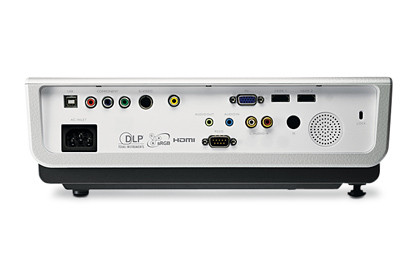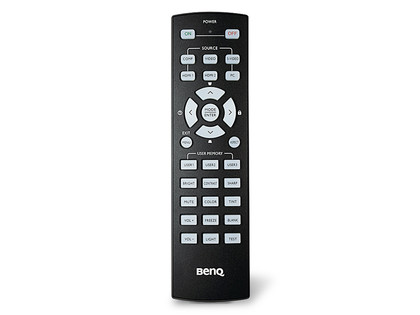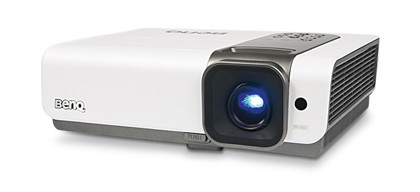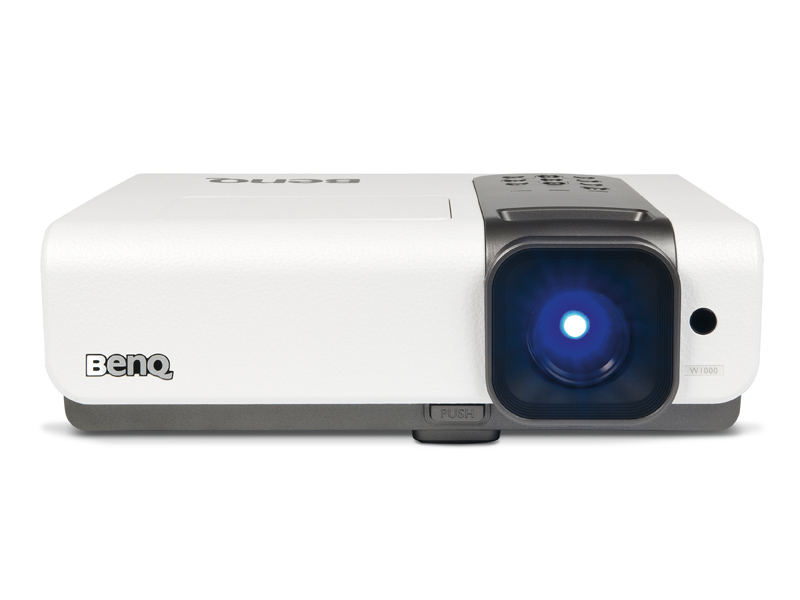TechRadar Verdict
Nicely priced and neatly put together, this compact, full HD beamer is capable of some serious cinema
Pros
- +
Small size
- +
Reliable colour accuracy
- +
Decent contrast range
Cons
- -
Rainbow effect
- -
Blur
- -
Slight softness
Why you can trust TechRadar
After lagging behind flat tellies for a few years in terms of affordability, projectors are rapidly getting cheaper. BenQ's return to the fray with the W1000 DLP projector puts excellent Full HD home cinema firmly within reach of those that want big pictures, but don't want to pay out extortionate amounts of cash.
Considering its sub-£1,000 starting price (it's a mere £999 bargain hunters), the W1000 crams some pretty advanced circuitry into its svelte white casing. BenQ has not spent too long on its design, however, so this DLP product very much resembles an office projector.
Inside there's evidence to the contrary: a high speed six-segment colour wheel and full HD resolution makes it a candidate for using with Blu-ray and HD games consoles.
The six-segment wheel is very important as it's likely to lessen the 'rainbow effect' that can cause some viewers to see seriously distracting colour banding during projections.
Inside its petite shell is BrilliantColor processing (to boost mid-tone hues), 3D Color Management (enabling endless calibration) and Unishape technology, which links up with the colour wheel to pump up the lamp's brightness when necessary.
That's crucial because some DLP beamers do struggle with bright footage, although the W1000 claims both a high 2,700:1 contrast ratio and a reasonable 1,800 ANSI Lumens brightness. The manufacturer also states that the lamp will last for up to 4,000hrs, which is on a par with most rivals.
Unusually for a projector, the W1000 does have a 3W speaker (albeit almost invisible) on its rear panel, which is very handy, though isn't going to shake the walls down.
Sign up for breaking news, reviews, opinion, top tech deals, and more.
The PC-style audio in/out minijacks also hint at BenQ's heritage in making business projectors.

Of more use in a home cinema outfit are the W1000's dual HDMI inputs, which combine with component video ports to create a trio of hi-def inputs. Although a USB port is present, it can't hook up memory sticks or cameras.
Ease of use
The W1000 creates a great first impression by being incredibly small. Being easily stowable is a tremendous selling point, but the install process is not so appealing. A drop-down leg beneath the front fascia can be extended and hidden at the touch of a button, while a flap on the top gives quick access to the lamp, but that's where the useful features end.
It lacks manual lens shift, which makes correct positioning easier. Keystone correction alone is not enough, nor is the W1000 easy to place; situated just over a couple of metres away from the screen, it produces an image of only around 70in.
It's not often that we test a projector with a control panel on the unit itself, but the W1000 hosts buttons to access and navigate onscreen menus, as well as to change the source and switch between various picture modes.

If you'd rather take a seat, the orange backlit remote is as comprehensive and as well designed as any we've seen. It's also very quick, which makes navigating the thoughtfully laid out, onscreen menus a pleasant experience.
Delve into them and you find the W1000's 3D Colour Management feature, which proves useful. It's also possible to change the levels for saturation, gain and hue for all primary colours via the remote. Add to that tweaks for colour temperature, white peaking and the usual sharpness/contrast/ brightness settings and the W1000 is something quite unusual if you're after a customised experience at little cost.
All your tweaks can be saved and assigned to specific buttons on the remote. Preset picture modes are not exactly plentiful with 'cinema', 'dynamic' and 'standard' settings only, though an eco mode is also on hand that prolongs the lamp's life.
Picture
Out of the box, the W1000 makes a decent stab at House of the Flying Daggers on Blu-ray, though some time spent tinkering with the 3D Colour management menus proves worthwhile, yielding some of the most natural colours we've seen at this price.
It's so realistic that there's rarely any need to toggle on the W1000's BrilliantColour feature. It does boost brightness and the saturation of the colours, as demonstrated by extra vividness in the palace walls, as well as in the characters' colourful costumes, but if anything, it's suppression of the all-round cinematic tone is rarely needed.
While bright enough to be used in some degree of daylight, the W1000 isn't perfect. We noticed some blurring during the many fastmoving fight scenes of our test disc, as well as some picture noise.
It isn't the sharpest picture we've seen from a DLP projector, either, but when it comes to contrast, deep and detail-strewn blacks are common, though hardly reference-grade. Unfortunately, in contrast-heavy scenes below deck in Master & Commander we noticed the rainbow effect, which does detract from the regularly impressive picture quality that lies at the core of the W1000.
Value
Aside from its robust pictures, the W1000's chief extra feature – it's built-in mono speaker – proves very useful. Although best kept for emergencies only, the sound quality is just about acceptable for dialogue, chiefly because there's no hint of distortion even at high volumes.

Although blighted by rainbows and the occasional blur, this heavily customisable projector is a great value product that overcomes its less-than-flexible setup to impress with well-rounded HD pictures.
BenQ has come up with a good first attempt at a budget full HD lightbox that just about justifies its price.
Follow TechRadar Reviews on Twitter: http://twitter.com/techradarreview

Jamie is a freelance tech, travel and space journalist based in the UK. He’s been writing regularly for Techradar since it was launched in 2008 and also writes regularly for Forbes, The Telegraph, the South China Morning Post, Sky & Telescope and the Sky At Night magazine as well as other Future titles T3, Digital Camera World, All About Space and Space.com. He also edits two of his own websites, TravGear.com and WhenIsTheNextEclipse.com that reflect his obsession with travel gear and solar eclipse travel. He is the author of A Stargazing Program For Beginners (Springer, 2015),
